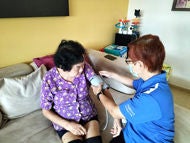What is - Marfan Syndrome
What is Marfan syndrome?
Marfan syndrome is a genetic disorder of the connective tissue, particularly affecting the heart, blood vessels, skeleton and eyes. Connective tissue provides the structural support and helps maintain the elasticity of the ligaments, skeletal structures, blood vessel walls and the heart valves.
How common is Marfan syndrome?
It is estimated that one in 5,000 to 10,000 people are born with Marfan syndrome. It can occur in all races and affect both genders equally.
What are the types of Marfan syndrome?
Marfan syndrome does not have distinct subtypes but can vary in severity and presentation. However, related conditions and terms often used in association with Marfan syndrome include:
- Classic Marfan syndrome: Typical features involving the cardiovascular, skeletal and ocular systems.
- Neonatal Marfan syndrome: A rare and severe form present from birth, often with significant heart and lung involvement.
- Related connective tissue disorders: Conditions such as Loeys-Dietz syndrome or Ehlers-Danlos syndrome, which may overlap with some features of Marfan syndrome.
- Isolated features of Marfan syndrome: Cases where only one or two systems are significantly affected, not meeting full diagnostic criteria.
Symptoms of Marfan Syndrome
What are the features of MFS?
While Marfan syndrome may be present at birth, some symptoms develop gradually over a number of years. The severity of symptoms varies from person to person, even among affected family members.
The main features include:
- Cardiovascular (heart and blood vessels): Weakening and stretching of the blood vessels can occur. This applies in particular to the aorta (the main blood vessel carrying blood away from the heart) and increases the risk of aortic aneurysm, dissection or rupture (bursting).
The heart’s valves may also be affected. The most common condition is mitral valve prolapse (MVP). In MVP, the valve leaflets become floppy and do not close tightly. This can cause leakage of blood backwards across the valve. This is known as mitral regurgitation (MR). If mitral regurgitation progresses and is left untreated, it can eventually cause heart failure. - Lungs: Asthma, emphysema, pneumothorax (collapsed lung)
- Skeleton: Tall and thin with long arms, legs, fingers and toes. Flat feet, protruding or indented chest bone, loose joints, scoliosis and skin stretch marks.
- Eyes: Dislocation of lenses, myopia (shortsightedness), retinal detachment, glaucoma
- A family history of Marfan syndrome in a parent, sibling or child
When should you see a doctor?
Seek medical attention if there is:
- Chest pain or breathlessness
- Sudden blurring of vision
- Joint pain
Marfan Syndrome - Causes and Risk Factors
What causes MFS?
Marfan syndrome is caused by changes in the FBN1 gene located on chromosome 15. Genes are instructions for cells to make proteins in the body. Marfan syndrome is the result of a change (mutation) in the FBN1 gene.
This gene controls the production of fibrillin-1, which is a very fine fibre that is found in connective tissue. Fibrillin fibres come together to form an elastic mesh which helps to support certain structures in our body, such as blood vessel walls and the lens of the eye.
Fibrillin-1 also regulates the activation of transforming growth factor beta (TGF-β) binding protein, which takes part in the regulation of many different cell functions and affects connective tissues throughout the body.
Everyone carries two copies of each gene, one inherited from each parent. Marfan syndrome follows a dominant inheritance pattern, which means the presence of one faulty FBN1 gene can cause the condition.
What are the risk factors for Marfan syndrome?
The primary risk factor for Marfan syndrome is a family history of the condition. Marfan syndrome is inherited in an autosomal dominant pattern, meaning that having one parent with the condition significantly increases the likelihood of inheriting it.
Is Marfan syndrome inherited?
If either parent has Marfan syndrome, a child has a 50% chance of inheriting the disease.
Among people with the condition, about 75% of them would have inherited the genetic change from one of their parents. As some people may have a mild form of the disorder, the parent may not have been previously recognised as having Marfan syndrome.
The other 25% of people with Marfan syndrome have it because of a new mutation in the gene.
Diagnosis of Marfan Syndrome
How is MFS diagnosed?
Marfan syndrome is diagnosed based on a full evaluation by a doctor familiar with the disorder. This involves the following:
- Thorough physical examination
- Complete family history
- Full eye examination
- Echocardiogram (ultrasound of the heart)
- Genetic testing for a causative mutation in the FBN1 gene can also provide helpful information
- Full eye examination in some cases
Treatment for Marfan Syndrome
How is Marfan syndrome managed?
While it is not possible to cure Marfan syndrome, much can be done to make sure you/your child has the best possible outcome.
The multidisciplinary medical team looking after you/your child will be able to address specific medical concerns and routine Marfan syndrome-related health issues.
Management measures may include:
· Regular echocardiograms: To assess the heart and width of the aorta; medications and/or surgery may be required if the width of the aorta becomes too wide.
· Maintaining good dental and skin hygiene: Important for reducing the risk of infection of the heart valves.
· Antibiotic prophylaxis: May be required before surgery and dental procedures in some cases; please discuss with your doctor for the latest updates on antibiotic prophylaxis.
· Careful monitoring of the skeleton: To detect problems with the spine or chest bone.
· Regular eye examinations: To monitor for myopia and lens dislocations.
There are also important lifestyle considerations for an individual with Marfan syndrome:
- Ensure a balanced diet, engage in low-intensity exercise and avoid smoking. These measures are also good for general health.
- Avoid heavy weightlifting and contact sports. Discuss with your doctor about recommendations for exercise and activities.
- With proper management of the cardiovascular manifestations, the life expectancy of someone with Marfan syndrome approximates that of the general population.
For individuals with Marfan syndrome who are pregnant:
Pregnant women with Marfan syndrome may be at high risk of obstetric and cardiac complications due to increased stress on the aortic wall especially during delivery. Please consult your doctor for preconception care and counselling.
FAQs on Marfan Syndrome
If a parent has Marfan syndrome, the risk of having a child inherit the gene that causes it is 50% in every pregnancy.
In about 25% of cases, Marfan syndrome is the result of a spontaneous change (mutation) in the genetic material of the sperm or egg at conception in families with no previous history of the disease. In such cases, the risk of having another child with the disorder is low (< 1%).
With advances in medical care and monitoring, individuals with Marfan syndrome can now have a near-normal life expectancy. Regular cardiovascular monitoring, timely interventions and lifestyle adjustments play a critical role in managing potential complications and improving quality of life.
Marfan Syndrome - Other Information
MFS is a lifelong condition. Should you require financial assistance or emotional support, please approach your doctor for referral to a medical social worker.
| Support Groups |
|---|
Club Rainbow Singapore |
Download the Marfan Syndrome brochure.
Contributed by
The information provided is not intended as medical advice. Terms of use. Information provided by SingHealth.
Get to know our doctors at SingHealth Hospitals in Singapore.
Get to know our doctors at SingHealth Hospitals in Singapore. here.






















